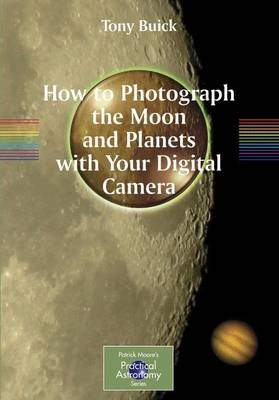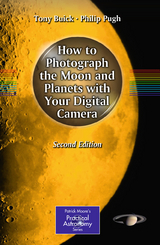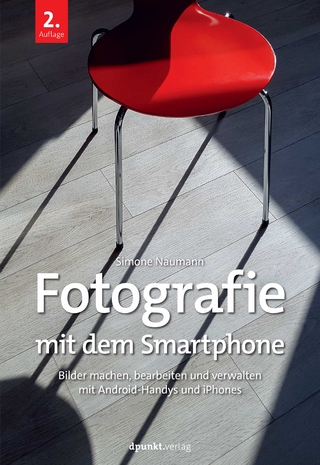How to Photograph the Moon and Planets with Your Digital Camera
Seiten
2006
|
and ed.
Springer London Ltd (Verlag)
978-1-85233-990-6 (ISBN)
Springer London Ltd (Verlag)
978-1-85233-990-6 (ISBN)
- Titel erscheint in neuer Auflage
- Artikel merken
Zu diesem Artikel existiert eine Nachauflage
Since the advent of astronomical CCD imaging, it has been possible for amateurs to produce images of a quality that was attainable only by universities and professional observatories. This illustrated step-by-step manual is for anyone who has a telescope (of any size) and a digital camera. It provides a photographic atlas of the Moon.
Since the advent of astronomical CCD imaging it has been possible for amateurs to produce images of a quality that was attainable only by universities and professional observatories just a decade ago. However, astronomical CCD cameras are still very expensive, and technology has now progressed so that digital cameras - the kind you use on holiday - are more than capable of photographing the brighter astronomical objects, notably the Moon and major planets. Tony Buick has worked for two years on the techniques involved, and has written this illustrated step-by-step manual for anyone who has a telescope (of any size) and a digital camera. The color images he has produced - there are over 300 of them in the book - are of breathtaking quality. His book is more than a manual of techniques (including details of how to make a low-cost DIY camera mount) and examples; it also provides a concise photographic atlas of the whole of the nearside of the Moon - with every image made using a standard digital camera - and describes the various lunar features, including the sites of manned and robotic landings.
Since the advent of astronomical CCD imaging it has been possible for amateurs to produce images of a quality that was attainable only by universities and professional observatories just a decade ago. However, astronomical CCD cameras are still very expensive, and technology has now progressed so that digital cameras - the kind you use on holiday - are more than capable of photographing the brighter astronomical objects, notably the Moon and major planets. Tony Buick has worked for two years on the techniques involved, and has written this illustrated step-by-step manual for anyone who has a telescope (of any size) and a digital camera. The color images he has produced - there are over 300 of them in the book - are of breathtaking quality. His book is more than a manual of techniques (including details of how to make a low-cost DIY camera mount) and examples; it also provides a concise photographic atlas of the whole of the nearside of the Moon - with every image made using a standard digital camera - and describes the various lunar features, including the sites of manned and robotic landings.
Foreword by Sir Patrick MoorePrefaceIntroduction Equipment The Magic Ingredient Method The Universe and You Targets Our Moon The Moon -- First Glance Regions of the Moon Moon Features and Techniques Lunar Events Solar System Moons The Planets The Sun Transits !and What Else? ConclusionAppendices
| Erscheint lt. Verlag | 1.2.2006 |
|---|---|
| Reihe/Serie | Patrick Moore's Practical Astronomy Series |
| Zusatzinfo | 47 black & white illustrations, 265 colour illustrations, 43 black & white halftones, 265 colour illustrations, 4 black & white line drawings |
| Verlagsort | England |
| Sprache | englisch |
| Maße | 178 x 254 mm |
| Einbandart | Paperback |
| Themenwelt | Kunst / Musik / Theater ► Fotokunst |
| Sachbuch/Ratgeber ► Freizeit / Hobby ► Fotografieren / Filmen | |
| Sachbuch/Ratgeber ► Natur / Technik ► Weltraum / Astronomie | |
| ISBN-10 | 1-85233-990-X / 185233990X |
| ISBN-13 | 978-1-85233-990-6 / 9781852339906 |
| Zustand | Neuware |
| Haben Sie eine Frage zum Produkt? |
Mehr entdecken
aus dem Bereich
aus dem Bereich
Bilder machen, bearbeiten und verwalten mit Android-Handys und …
Buch | Softcover (2023)
dpunkt (Verlag)
CHF 38,90
die faszinierende Welt der Bäume verstehen und stimmungsvoll in Szene …
Buch | Hardcover (2024)
dpunkt (Verlag)
CHF 51,65





